AMD Announces Carrizo and Carrizo-L, Next Gen APUs for H1 2015
by Ian Cutress on November 20, 2014 5:45 PM EST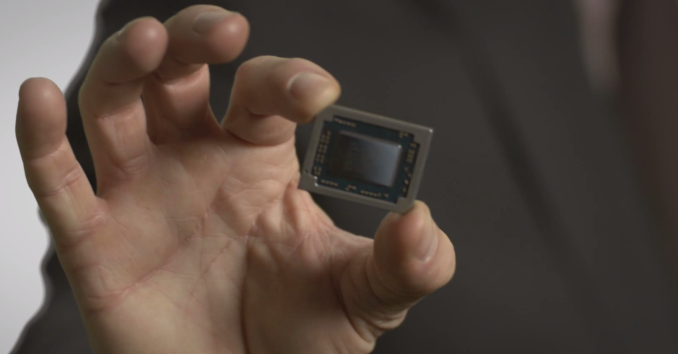
Today AMD is announcing the long anticipated upgrade to Kaveri, codenamed Carrizo. Carrizo is the natural successor to Kaveri, featuring x86 ‘Excavator’ cores alongside a Radeon-class GPU and promising an increase in performance all around. The second part of today’s announcement is for Carrizo-L, an SoC pairing “Puma+” (upgraded Beema) cores also with AMD’s R-series GCN GPUs and a FCH into a single package. Both Carrizo and Carrizo-L will feature ARM Trustzone, giving potential hardware-based built-in security when used by developers.
The Excavator cores are an architectural improvement over Steamroller, but are fundamentally based on the original Bulldozer concept. Excavator will be AMD’s fourth iteration of the concept, following Bulldozer, Piledriver and Steamroller. This new generation of APUs are still set to be built on the 28nm Super High Performance process at Global Foundries, delaying AMD’s shift to 20nm, but AMD are still claiming that the new GPU in Carrizo is their best yet, giving better performance and efficiency than before.
Given AMD's discrete GPU lineup, the GPU for Carrizo could be based on AMD's latest GCN 1.2 architecture, which was first introduced in the desktop Tonga part earlier this year. GCN 1.2's lossless delta color compression algorithms help improve the performance in memory bandwidth limited scenarios, such as in APUs. This could result in a bigger-than-expected jump in performance, although we will wait until we can test to find out how much it helps.
The Carrizo platform will be fully HSA 1.0 compliant, compared to Kaveri which only had ‘HSA Features’, as AMD puts it in their latest mobility roadmap update:
The push from AMD into HSA compliant APUs was well documented back at the launch of Kaveri earlier this year. This enabled the CPU and GPU components of the silicon, while under OpenCL 2.0 mode, to have access to the main block of system DRAM with zero-time copy functions, offering the potential for large classes of applications especially those in the prosumer and industry space to be accelerated by having instant access to the parallelization afforded by the GCN GPU. One of the big drawbacks of being an earlier adopter to HSA, as we noted at the time, was that software developers required time to bring their code to market, as well as AMD having to go out and teach the developers how to cater for HSA topology.
Both Carrizo and Carrizo-L on the mobile side will be targeted at the same power bands as Kaveri and Beema, although the socket will be new. The use of FP4 BGA also indicates that a single socket will cater for both the Excavator and Puma+ based APUs and would be interchangeable. A video by AMD’s VP/GM for Computing and Graphics, John Byrne, states that Carrizo and Carrizo-L are currently being tested internally ready for a 1H 2015 release, along with support for DirectX 12, OpenCL 2.0, Mantle and Freesync.
One of the big features that AMD is pushing with Carrizo is energy efficiency, with it being a keystone of the message. Because AMD have been on the same process node for a short while, they have to essentially follow the Maxwell example, by providing more performance for less power without the advantage of shrinking resistors. We were provided with an energy efficiency roadmap as well, showing the different methods AMD is using to achieve this:
One example of the efficiency improvement was provided by AMD’s Voltage Adaptive Operation. Rather than compensate for voltage variations which wastes energy, this technology takes the average operating voltage and detects when the voltage increases beyond a smaller margin. To compensate for this increase, the CPU speed is reduced until the voltage drops below the threshold and then the CPU speed is moved back up.
The changes in speed are designed to be so minute that it does not affect overall performance, however it might only take an errant voltage delivery component to consistently make the voltage go above that threshold, causing erratic slowdown that might be statistically significant. It will be interesting to see how AMD implements the latest version of this feature.
The 2015 desktop roadmap remains unpublished so far. AMD’s perception of a mobile-focused strategy would tend to suggest that the mobile comes first, with desktop following behind, although at this point it is unclear. A number of AMD’s marketing materials with this launch gave examples of the use of Carrizo and HSA for the prosumer, indicating that a desktop version should be announced in due course.
As of yet there was no discussion on the APUs to be launched, the speeds or the capabilities. All the roadmap tells us is 'up to four cores' (Excavator for Carrizo, Puma+ for Carrizo-L), some GCN compute units and 10-45W overall. There is no mention of DDR4 support, although the timeframe might be relevant for AMD to make the jump. Given the launch is still at least two quarters away, I would expect better details in due course. That timeframe fits in nicely around or just after Computex, perhaps indicating more details then.
Source: AMD


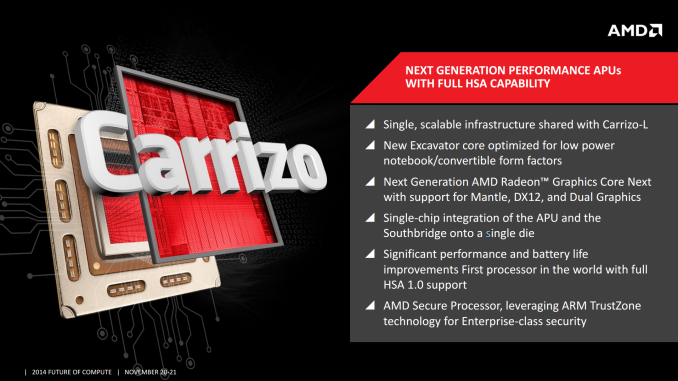
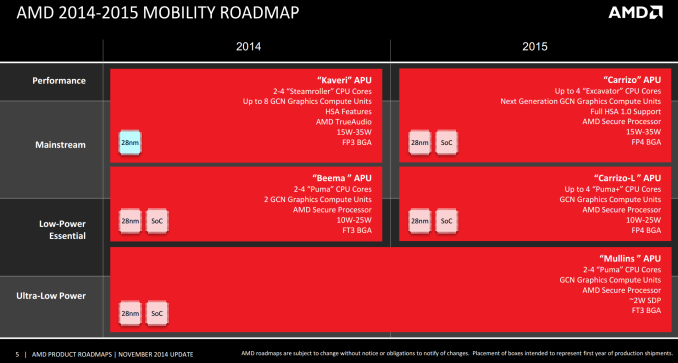
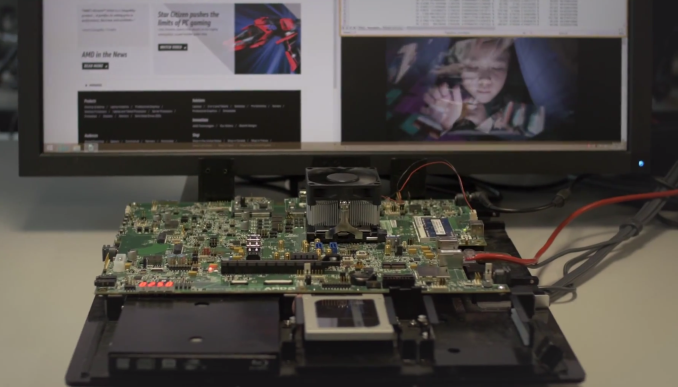
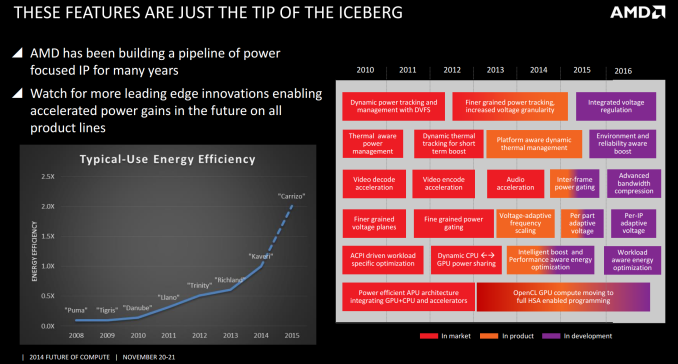
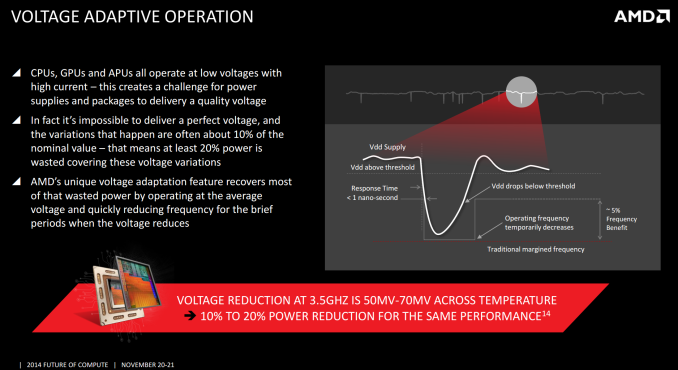
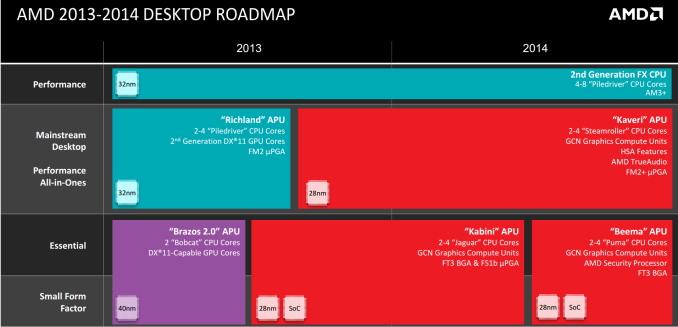








94 Comments
View All Comments
zepi - Saturday, November 22, 2014 - link
Ofc AMD's chips are ignored by OEM's since they are utter crap compared to Intel, Qualcomm and Nvidia chips. Why would an OEM pick something that has by far worse perf/w and idle usage characteristics than competition?AMD has two product lines that are really competitive. APU's with highend Graphics (Console chips in Xbox one and PS4) and desktop class GPU's. Intel can't compete with GPU's, Nvidia doesn't have fast x86 CPU's and Qualcomm doesn't have high-tdp products.
For some reason AMD has not capitalised on this opportunity, but instead it has tried to compete in a market where it doesn't have competitive products. Not to mention that it hasn't had R&D resources to catch competition.
mikato - Monday, November 24, 2014 - link
They can't get any more consoles since I think they got them all :) As for desktop class GPUs, they're in heated battle with Nvidia as you know. I'm still not sure why I hear they have smallish market share here though.StevoLincolnite - Wednesday, November 26, 2014 - link
There are still hundreds of millions of "consoles" AMD could get the drop on, *if* they play their cards right. (Geddit?)And that's the mobile sector, if AMD can have good enough performance, with low power and at the right price they may end up being an attractive proposition for Nintendo's and Sony's hand held consoles. (I bet they regret selling it's mobile Radeon business, aka. Adreno.)
Obviously, it won't be high-profit monolithic chips, but AMD can do with the extra business.
Hrel - Friday, November 21, 2014 - link
"Where is my 250W TDP highly clocked 4-core Steamroller with integrated 7970 class GPU, soldered to motherboard with enough edram / sram for framebuffer, 4GB of GDDR5 + two DDR3 sockets? Shipped with AIO water cooler? With clever driver programming to benefit from all the bandwidth and shared memory space with low level mantle api? The ultimate fusion of paraller- and serial computing power that became theoretically possible when AMD bought ATI?"Are you insane 0_0? Honestly, have you been checked?
that tech guy - Friday, November 21, 2014 - link
you are kind of missing the point . sure for absolute best performance a intel cpu with a nvidia card is best for most gaming . but do you need anything better than a i7 4770 ? that is intells dilemma .skylake has been pushed back . intels alleged answer to amds apu's that can play games . skylake is 2016 now . amds problem for years now has been its tdp situation . with that little problem resolved it can then go back to simply building on the number of cores it uses on the dies since they will also be smaller . sooo carizo is 2015 and skylake is 2016 . do you think intel will be able to out preform amd with their integrated solution on gaming with zero help from nvidia in 2016 ? because thats all that other companies care about . steam has a slew of publishers who has started putting up in the minimum requirements that intel integrated graphics are not supported .
if for instance better than a i7 4770 isn't needed for years especially because the new systems dont have massive cpu power and AAA developers for the first time EVER have the ability to port things faster because the hardware is using x86 architecture on all platforms than what will intel have in 3 years ? cheap i7's sure but they want top end product to move
Michael Bay - Friday, November 21, 2014 - link
Tdp situation.Little problem.
You can tell things are going bad when everything AMD has to shill with are the likes of you.
piroroadkill - Friday, November 21, 2014 - link
Agreed. AMD could be making absolutely killer HTPC chips for gaming, but none of their APUs actually go all the way and have enough beef to the GPU.ddriver - Friday, November 21, 2014 - link
Don't you worry, IC process is soon going to hit a size limit brick wall, AMD and the rest will have time to catch up ;)Morawka - Friday, November 21, 2014 - link
that's called denial lol... I guess you could call it "hope" as well. The "brick wall" wont happen for at least 6-10 years, and to be honest, i don't think AMD can last that longtarqsharq - Wednesday, November 26, 2014 - link
I dunno, their chips are in all three of the current generation consoles. That's some business there.